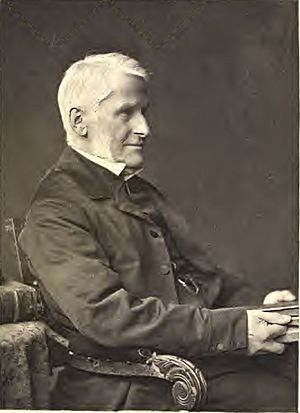Edward Hoare (priest) facts for kids
Edward Newenham Hoare (born April 11, 1802 – died February 1, 1877) was an Irish priest in the Anglican church. He studied at Trinity College, Dublin. He held important positions, serving as Archdeacon of Ardfert from 1836 to 1839. After that, he became Dean of Achonry from 1839 to 1850, and then Dean of Waterford until he passed away.
His Life and Work
Edward Hoare was born in Limerick. His father was Reverend John Hoare. After finishing college in 1824, Edward worked as a curate (a junior priest) in places like Parwich and Alsop en le Dale in England. Later, he moved back to Ireland.
Around 1830, he was a curate at St. John's Church in Limerick. He worked hard to raise money from people in England and Scotland. In 1834, he helped build a new church for the parish of St. Lawrence. This church was also connected to a charity that helped blind women.
In 1835, Edward Hoare became the Rector of St Lawrence in Limerick. A year later, he was made Archdeacon of Ardfert. In 1839, he became a chaplain to Hugh Fortescue, who was the Lord Lieutenant of Ireland (a high-ranking official).
Edward Hoare was interested in education. He shared his views on Ireland's national education system with a special committee in the House of Lords. He also joined the Church Association in 1865, which was a group focused on church matters. He was also a Vice-President of the National Education League for Ireland.
Edward Hoare died in Upper Norwood, England, on February 1, 1877.
The Christian Herald
Edward Hoare was known as a strong preacher who believed in spreading the Christian message. He also edited a religious magazine called The Christian Herald. This magazine was published in Dublin from 1830 to 1835. It focused on Christian prophecies and beliefs about the future.
The magazine reported on important meetings about prophecy that took place at Powerscourt House. It also featured articles by a writer named John Nelson Darby. The Christian Herald shared ideas about how Christ's rule would continue for a very long time.
His Writings
Edward Hoare wrote many sermons and other books. Here are some of his notable works:
- Practical Observations on Church Reform, the Tithe Question and National Education in Ireland (1838) - This book discussed ways to improve the church, issues with tithes (church taxes), and education in Ireland.
- The Tendency of the Principles advocated in the Tracts for the Times considered (1841) - In this work, he gave advice to new priests, suggesting they be careful about certain religious ideas.
- The Time of the End; or, The World, The Visible Church, and the People of God, at the Advent of the Lord. (1846) - This book explored ideas about the end times and the return of Christ.
- The Duty and Expediency on the Part of the Landed Proprietors of Ireland, of Co-operating with the Board of National Education (1847) - This was a letter encouraging landowners in Ireland to work with the national education system.
- The English Settler's Guide Through Irish Difficulties (1850) - A guide for English people moving to Ireland.
- Remarks on certain mis-statements as to the extent of scriptural education in Ireland (1850) - This book talked about education in Ireland before the national system was set up.
- English Roots, and the Deviation of Words from the Ancient Anglo-Saxon (1856) - Two lectures about the origins of English words from old Anglo-Saxon.
- Exotics: Or, English Words Derived from Latin Roots: Ten Lectures (1863) - Ten lectures explaining English words that come from Latin.
His Family
Edward Hoare was married twice. His first wife was Louisa Mary O'Donoghue, whom he married in 1832. They had two sons and three daughters. One of his sons, also named Edward Newenham Hoare, became a priest and writer too, and sometimes people confuse their works.
After Louisa passed away in 1858, Edward married Harriet Wilson in 1859. Harriet had been married before, and Edward became a stepfather to her daughter, Emma Harriet, who later became the 12th Baroness Berners. Edward and Harriet did not have any children together.



